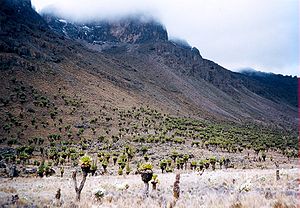Kenya vedeyaf gerd
|
Kenya vedeyaf gerd ( englavon Mount Kenya National Park ), tir burkaf debak ke Kenya. Kenya vedeyaf gerd tir tano katcalapafo tuwavaxo ke tawava nume bak 1997 wetce tuwavaf debak ke tamavafa gadakiewega ke UNESCO zo bendeyer.
Dem ontine vas 5199 m-, Kenya mefta tir toleafe logijafe ontine ke Afrika. Tir savsaf volrunkaf tculk co tiyis dem 6500 m- bak intaf runkugal ( weti 3.1 ik 2.6 decitda ). Mon san-toloyo opraxo moe meftava lapted voxe kalion illaumad, isen balemoya banafa otsa katice krantay wan tigid. Ton yona tcurtafa arna opraxokirafa is mialukafa datca, Kenya mefta tir tan lowoes patectoy ke ronefa Afrika. Towara is tuwavopa va afrikalpaf ruxeem ke Kenya mefta va burkafa tula ke tuwavafa is blifa abduaxa tiskad. Dem dere Videxo va govitoleem ke Lewa is aalafo Videxo ke Ngare Ndare, debak va suyaf krant dem omafa krimpa is lidafo irubaxo ruldar, i dem tadlexa kulafa gu bligedruca tigisa koe tuwavaf vegem zeviandas wal meftaf blibolk is lindamafa meilafa werda. Debak moe prostewafa kelda ke lamara ke yona sanelia ke afrikaf fuzol dere tigir. ~ UNESCO : Kenya vedeyaf gerd (en) At 5,199 m, Mount Kenya is the second highest peak in Africa. It is an ancient extinct volcano, which during its period of activity (3.1-2.6 million years ago) is thought to have risen to 6,500 m. There are 12 remnant glaciers on the mountain, all receding rapidly, and four secondary peaks that sit at the head of the U-shaped glacial valleys. With its rugged glacier-clad summits and forested middle slopes, Mount Kenya is one of the most impressive landscapes in East Africa. The evolution and ecology of its afro-alpine flora provide an outstanding example of ecological and biological processes. Through the Lewa Wildlife Conservancy and Ngare Ndare Forest Reserve, the property also incorporates lower lying scenic foothills and arid habitats of high biodiversity, situated in the ecological transition zone between the mountain ecosystem and the semi-arid savanna grasslands. The area also lies within the traditional migrating route of the African elephant population. ~ UNESCO website, licence CC-BY-SA IGO 3.0
Ewava va debakbetara
Vuestexabetara
|
 | ||||||||||||||||||||||||||||||||||||||||










